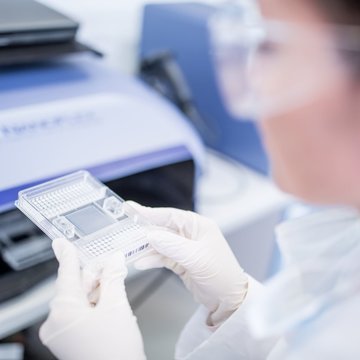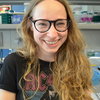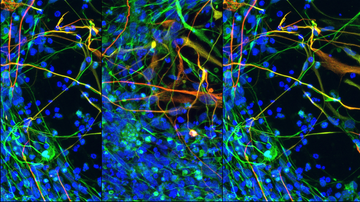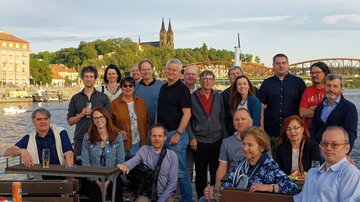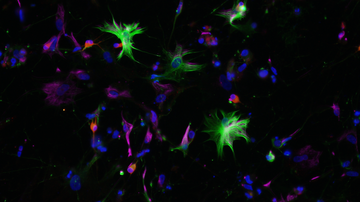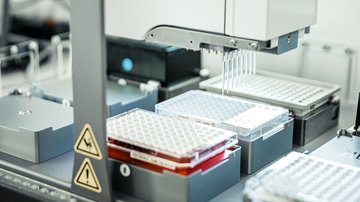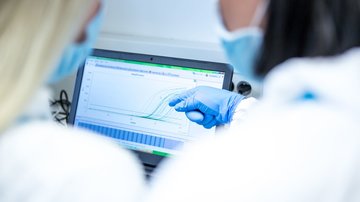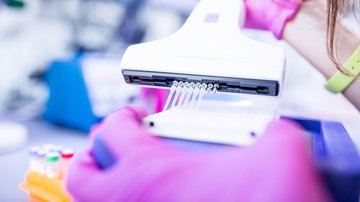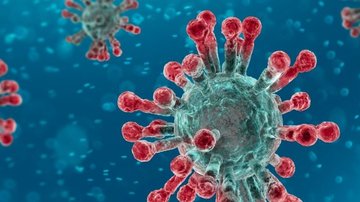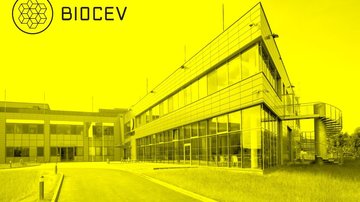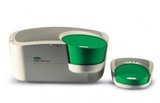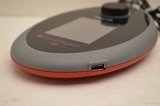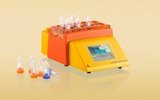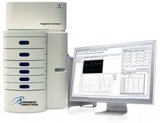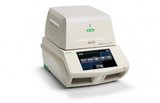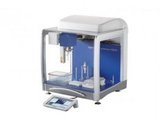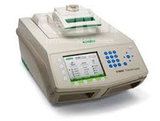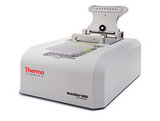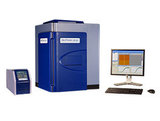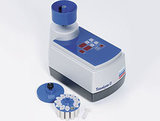Absolute quantification
We offer to perform an absolute quantification for you.
One of the choices for absolute quantification is an intrapolating your unknown samples from a standard curve prepared from standards of known concentration. Concentration is presented as number of copies.
The experiment can also be prepared by automatic pipetting system EpMotion.
ATTENTION: If the standard curve is not precise or is not prepared from the sample similar to the quantified unknown sample, then the concentration obtained from such a standard curve is also not precise or might be wrong. The external calibration curve model has to be thoroughly validated as the accuracy of absolute quantification in real-time RT-PCR depends entirely on the accuracy of the standards. If the good standard is not available, you can try different method, a digital PCR



ADDITIONAL RESOURCES: http://qpcrupdate.com/bustin-2000.pdf
Relative quantification
We offer to design and perform qPCR experiment using relative quantification.
Most of qPCR experiments are designed as relative quantification. It means that the changes of expression in a target sample (for example a treated sample) are compared with gene expression of a reference sample (for example an untreated sample). All samples are usually normalized (for example with reference genes). A normalized target sample is compared with a normalized reference sample and as a result, the fold change of gene expression between 2 samples is calculated. The example: Expression of gene X in the treated sample is 5 fold lower than expression of gene X in the untreated sample.

ADDITIONAL RESOURCES:
http://gene-quantification.de/pfaffl-rel-quan-book-ch3.pdf
https://www.youtube.com/watch?v=y8tHiH0BzGY
http://www2.udel.edu/ctcr/sites/udel.edu.ctcr/files/Relative%20Quantification%20Guide.pdf
http://www.bio-rad.com/webroot/web/pdf/lsr/literature/Bulletin_5279.pdf
Selection of appropriate reference genes for your system
The reliability of any relative RT-PCR experiment can be improved by including an invariant endogenous control (reference gene) in the assay to correct for sample to sample variations in RT-PCR efficiency and errors in sample quantification. Ideal reference gene should be stable in ALL conditions of YOUR experiment. Unfortunately there are NO universal reference genes, expressed at constant levels under all conditions in all tissues. That is why candidate reference genes have to be validated for each experimental condition and each type of sample.

We offer to find stable reference genes for your experiment using a reference gene panel. The Reference Gene Panels offer an easy way of screening for reference genes as they contain a set of 12 highly efficient wet lab validated assays that are ready to use. Genes with varying cellular functions and expression levels have been selected to reduce the risk of using co-regulated genes. The primers have been designed to be exon-spanning where possible. There are 3 variants of the panel: for human, mouse and rat.

ADDITIONAL RESOURCES: http://gene-quantification.de/
http://www.tataa.com/wp-content/uploads/2012/10/Reference-Gene-Panel-Product-Flyer.pdf
Control of contamination with genomic DNA
Any RNA extraction method co-purifies DNA to some extent, usually around 1%, but can be up to 10%! Genomic DNA (gDNA) contamination is a problem that can lead to non-specific amplification and aberrant results in reverse transcription quantitative PCR (RT-qPCR).
How to identify and quantify gDNA contamination in RNA sample:
- Agarose gel: If there is a prominent band above the 28s peak, it might be a hint of gDNA contamination
- Check for DNA contamination using specific fluorescent dye present in Qubit dsDNA kit that would recognize DNA from RNA
- Run a qPCR with DNA-specific primers (i.e. that do work on DNA) on RNA. As RNA is no template for PCR, any signal you get is from contaminating DNA. The control can be done by ValidPrime (gDNA specific primers).
- Run a qPCR with your reference gene using your RNA instead of cDNA. If you get a signal, it cannot come from RNA, it would come from gDNA.
- RT- control: minus-reverse transcriptase control (“No Amplification Control” or NAC) in qRT-PCR experiments. Typically, the NAC is a mock reverse transcription containing all the RT-PCR reagents, except the reverse transcriptase. If a product is seen in the NAC in qPCR, it probably indicates that contaminating DNA is present in the sample. An unofficial rule-of-thumb is that you can disregard gDNA contamination (when doing relative quantification) if the gDNA amplifies >5 cycles after the cDNA amplification (i.e. >32 fold less).
How to get rid of genomic DNA:
- Dnase treatment, either on the column or after RNA purification on the RNA. You should verify after Dnase treatment, that the RNA is free of DNA.
- RT- control and use the GenEx software: the contribution to Cq from the genomic background can be calculated and the Cq values corrected.
- Using valid prime control and use the GenEx software: the contribution to Cq from the genomic background can be calculated and the Cq values corrected.
- Careful primer design: intron needs to be at least 700 bp when using an intron spanning assay; junction assays work too but are more difficult to design (not always possible).
We can control the purity of your RNA sample with ValidPrime. ValidPrime™ replaces the need to perform no reverse transcriptase (RT(-)) controls for all samples in your real-time quantitative PCR (qPCR) profiling to test for the presence of genomic DNA (gDNA). Just add the ValidPrime™ assay to the list of assays, and the gDNA control to the list of samples, and run. ValidPrime™ will minimize the amount of control reactions and hence your costs, as well as your efforts.In case there is a gDNA contamination in your RNA sample, the contribution to Cq from the genomic background can be calculated and the Cq values corrected.
Fig. Example of bad quantification of the sample contaminated with genomic DNA.

ADDITIONAL RESOURCES: http://genexp.ibt.cas.cz/145.pdf
Validation of new primers and probes
Providing all relevant assay characteristics can help reviewers to assess the validity of the results. If you buy assays from commercial providers, some characteristics, that are needed for your information or reviewer process for an acceptance of a manuscript, are often missing.
We offer performing all necessary experiments to obtain all relevant information that are needed according to the MIQE guidelines.
- Optimalization of the temperature profile of the experiment in order to reach the proper anneling temperature of your primers and probes
- Specificity of the assay: running electrophoretic gel (or microfluidic equivalents) and running melting profile during qPCR (if SYBR green the method of choice)
- Measuring the efficiency of the assay and finding out the dynamic range of the your experiment
Limit of detection or limit of quantification
- Quality controls: NTC (no template control = contamination control or primer dimer control), gDNA contamination controls (ValidPrime or RT-), positive or negative controls
- Optimalization of multiplex
Fig. Example of a serial dilution for finding out the efficiency of the primers


ADDITIONAL RESOURCES:
http://genexp.ibt.cas.cz/188.pdf
http://genexp.ibt.cas.cz/118-2.pdf
Inhibition control in RT and in qPCR
Contaminants present in samples are known to inhibit enzymatic reactions and in the context of a reverse-transcription quantitative Polymerase Chain Reaction (RT-qPCR) assay, inhibitors are fully capable of distorting reported measurements. The impact to Cq from the inhibition can NOT be recalculated and the Cq values corrected. The experimental sample containing inhibitors should be repurified and reanalyzed for correct biological interpretation. One solution to get out of inhibitors is diluting your sample. However, this approach is not applicable for all inhibitors.
The source of inhibition:
- From sample itself: tissue specific or sample specific inhibition, for example hemoglobin in blood
- From fixative where is sample fixed, for example FFPE
- From the isolation technique: for example trizol or chemicals used for stabilization of NA as EDTA, glycogen
- From reverse transcription: High concentration of RT enzyme is inhibitory or higher concentration of Taq polymerase that can be brought in reaction with higher volume of RNA
- From interaction of a specific qPCR templet with a specific probe or primer, especially if you have very high concentration of probe interaction
We can help you to discover inhibition in your reaction using spikes.
The test for inhibition is based on an efficient and simple principle: equal amounts of spike are added to all experimental samples and to an additional control sample. The control sample is based on nuclease-free water or purified matrix, which is known to be contaminants-free. All samples have the same volume. The experimental and the control sample are then reverse transcribed and amplified with the Spike Assay under identical conditions. If the Cq value is greater in an experimental sample than in the control then the analytical process of that experimental sample is inhibited. The magnitude of the difference between these Cq values reflects the degree of inhibition (from TATAA source).


ADDITIONAL RESOURCES: http://www.tataa.com/wp-content/uploads/2012/10/TATAA-Universal-RNA-and-DNA-Spike-Product-Flyer.pdf

